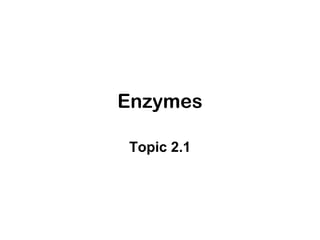
Enzymes
- 2. What are Enzymes? The chemical reactions that take place inside an organism, i.e. its’ metabolism, must be controlled. The rate of these metabolic reactions is controlled by enzymes. Enzymes are globular proteins (3-D spherical shape). They are usually named by adding the suffix –ase to the name of the substrate it helps metabolise. E.g. Maltase – helps break down the disaccharide maltose Lactase – helps break down the disaccharide lactose Amylase – helps break down the polysaccharide starch (amylose) • Enzymes regulate the metabolic processes that occur in cells • They are catalysts, they speed up reactions and are not used up themselves in the reaction • The energy needed to start a reaction is the ACTIVATION ENERGY • Enzymes lower the activation energy, so reactions can take place at acceptable temperatures in living organisms
- 3. Activation Energy Activation energy is the amount of energy required to start off a chemical reaction, where the reactant(s) are turned into product(s). The reaction will not occur unless ‘extra energy’ is given temporarily to the molecules: WITH ENZYME – when a WITHOUT ENZYME – substrate binds to an to change into a product the Potential Energy Potential Energy enzyme, the ActivationActivation (of molecules) energy of the substrate must (of molecules) Energy Activation Energy is lowered because be briefly raised by an Energy they split the reaction into amount Substrate(s)as the known Substrate Substrate(s) Substrate smaller stages Activation Energy Product(s) Product(s) Time Time http://www.sumanasinc.com/webcontent/animation
- 4. Why do enzymes increase the rate?
- 5. How Enzymes Work Enzymes are globular proteins, coiled into a precise 3-D shape, with hydrophilic side chains on the outer parts of the molecule (making them soluble). Enzymes have a special feature called an active site, where a substrate molecule(s) bind to, forming an ‘enzyme-substrate complex’. The substrate is then converted to product(s). Substrate (has complimentary Product shape) Enzyme Active Site Here side-chains of amino acids in the active site temporarily bind with the substrate Enzyme-substrate Enzyme + Substrate Enzyme + Product(s) Complex
- 6. Hypotheses This leaves the active site unchanged and ready to bind with another substrate molecule. This was traditionally called the ‘Lock and Key’ hypothesis because the substrate fits into a rigid active site like a key into a lock. This explains why enzymes are very specific (the substrate must fit the active site exactly to be catalysed). However this theory has since been developed into the ‘Induced Fit’ hypothesis. Here the active site is believed to change shape slightly so that the enzyme moulds itself around the substrate. (See fig 3, p.43) Now answer Qu.2 from p.43 in your book) http://www.sumanasinc.com/webcontent/animations/content/enzymes/enzymes.html
- 7. Models of enzyme action: lock-and-key
- 8. Models of enzyme action: induced fit
- 9. Enzymes: true or false?
- 10. What factors affect enzymes? The rate of an enzyme-controlled reaction is affected by several factors: temperature pH enzyme concentration (you must know in detail!) substrate concentration. Each enzyme works best within a range of conditions, and this range is different for each enzyme. Enzymes are also affected by the presence of inhibitors.
- 11. Effect of enzyme concentration on rate
- 12. Rate of reaction experiment
- 13. Effect of temperature on enzymes
- 14. Effect of pH on enzymes
- 15. Factors affecting rate of reaction
Hinweis der Redaktion
- Boardworks AS Biology Enzymes
- Boardworks AS Biology Enzymes Teacher notes This reaction involves the breakdown of a single substrate molecule into two product molecules, so it is an example of a catabolic reaction.
- Boardworks AS Biology Enzymes Teacher notes As the enzyme and substrate bind, it is possible that bonds in the substrate become stretched or strained, stabilizing the transition state of the substrate, which lowers the activation energy and enables bonds to be broken more easily. This reaction involves the breakdown of a single substrate molecule into two product molecules, so it is an example of a catabolic reaction.
- Boardworks AS Biology Enzymes
- Boardworks AS Biology Enzymes Photo credit: New Brunswick Scientific A BioFlo ™ Pro fermentor from New Brunswick Scientific, Edison NJ, USA. www.nbsc.com Teacher notes A fermentor, such as the one in the image, is a vital piece of equipment in the industrial use of enzymes as it makes it relatively easy to monitor and maintain optimum conditions.
- Boardworks AS Biology Enzymes
- Boardworks AS Biology Enzymes
- Boardworks AS Biology Enzymes Teacher notes Students could be asked if they can deduce the equation for calculating the Q 10 of this reaction based on the data from this graph. Q 10 = rate of reaction at x + 10 ° C / rate of reaction at x ° C
- Boardworks AS Biology Enzymes
- Boardworks AS Biology Enzymes
